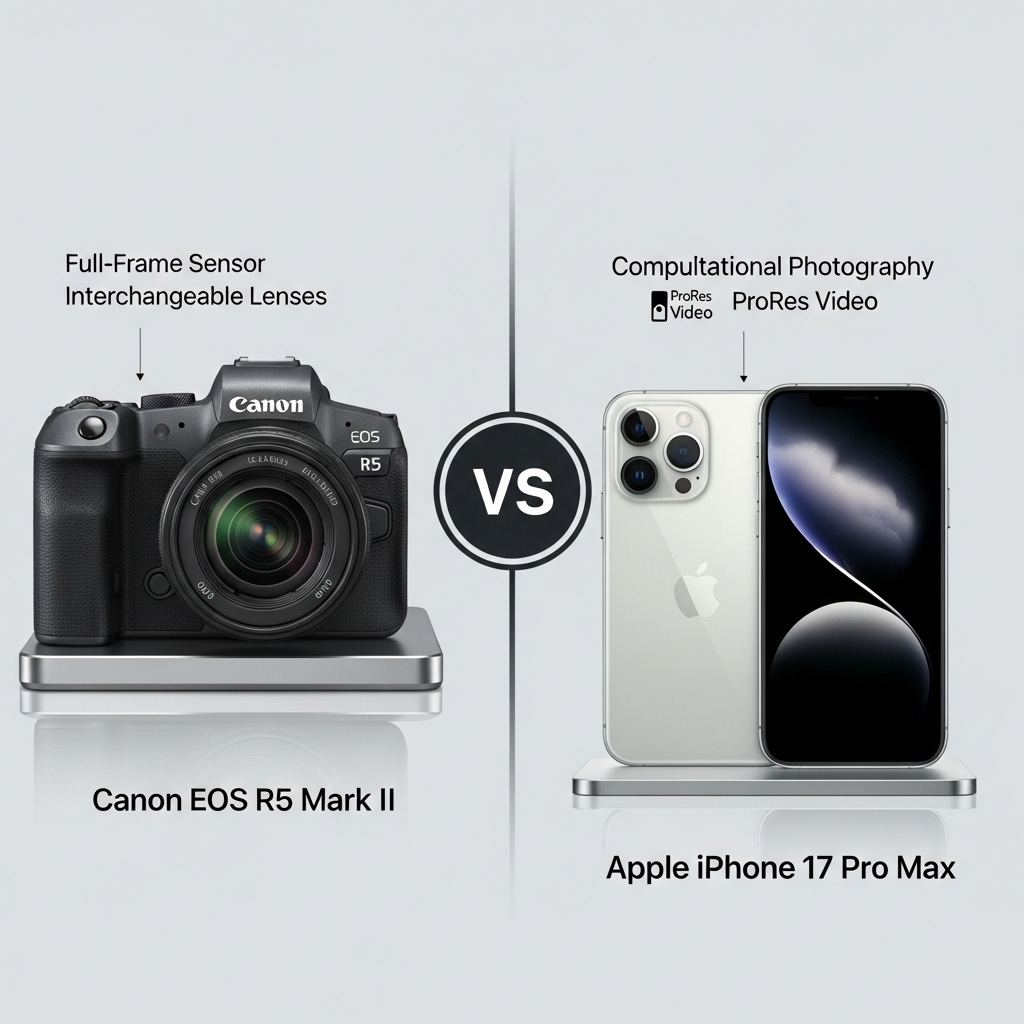Camera equipment > Canon EOS R5 Mark II vs. Apple iPhone 17 Pro Max (Computational Photography)
Many photographers and videographers grapple with the choice between a dedicated camera system and the convenience of a smartphone. This comparison examines the Canon EOS R5 Mark II and the Apple iPhone 17 Pro Max, focusing on their strengths in image quality, video capabilities, and overall usability.
This comparison analyzes real-world performance, user feedback, and key differentiators to help you make an informed decision.
Quick Verdict
For professional photographers and videographers prioritizing image quality and versatility, the Canon EOS R5 Mark II is the clear choice. For everyday users seeking convenience and advanced computational features, the iPhone 17 Pro Max is a strong contender.
- The Canon EOS R5 Mark II offers a significantly larger sensor and superior autofocus for professional-grade image quality.
- The iPhone 17 Pro Max provides advanced computational photography and convenient portability.
- The Canon excels in dynamic range and low-light performance due to its larger sensor.
Who Should Choose Which?
Choose Canon EOS R5 Mark II if:
Professional photographers and videographers who require the highest image quality, dynamic range, and lens versatility.
Choose Apple iPhone 17 Pro Max if:
Everyday users who value convenience, portability, and advanced computational photography features.

Key features – Side-by-Side
| Attribute | Canon EOS R5 Mark II | Apple iPhone 17 Pro Max (Computational Photography) |
|---|---|---|
| Image Sensor Size | Full-frame (36.0 x 24.0 mm) | — |
| Video Recording Capabilities | 8K RAW up to 60 fps, 4K up to 120 fps | — |
| Autofocus System | Dual Pixel Intelligent AF, 100% coverage, Subject Tracking (Humans, Animals, Vehicles) | — |
| Computational Photography | In-camera upscaling (to 179MP), Pre-continuous shooting | — |
| Weather Sealing | Moisture and dust-resistant seals, Magnesium alloy body | — |
Overall Comparison
Pros and Cons
Canon EOS R5 Mark II
- Superior dynamic range, sharpness, and color accuracy compared to smartphones
- Advanced subject recognition and tracking (humans, animals, vehicles)
- Effective IBIS (up to 8.5 stops)
- Wide range of video resolutions, frame rates, and codecs
- Robust weather sealing and durable construction
- High-quality RF lens options
- Complex menu system for beginners
- Managing numerous focus points can be complex
Apple iPhone 17 Pro Max (Computational Photography)
- Advanced computational photography features
- Improved low-light performance
- High-resolution video recording capabilities (8K)
- User-friendly interface
- Durable design with IP68 rating
- Ergonomic design with potential titanium frame
- Computational photography may produce artificial-looking images
- May fall short of dedicated cameras in terms of overall detail and natural rendering
- Image quality may be inferior to Canon EOS R5 Mark II, especially in challenging lighting conditions
User Experiences and Feedback
Canon EOS R5 Mark II
- No highlights reported.
- No major complaints reported.
- No value feedback reported.
Apple iPhone 17 Pro Max (Computational Photography)
- Expected to have all-day battery life with a larger battery (around 5000 mAh)
- Excellent stabilization systems combining OIS with software stabilization
- Computational photography may result in over-processed images compared to dedicated cameras
- May not match the dynamic range, sharpness, and color accuracy of cameras like the Canon EOS R5 Mark II
- No value feedback reported.
Frequently Asked Questions
Will the iPhone ever match the image quality of a full-frame camera?
While computational photography is improving rapidly, the laws of physics still favor larger sensors for dynamic range and low-light performance.
Is the Canon EOS R5 Mark II too complex for beginners?
The Canon has a steeper learning curve, but its advanced features and image quality make it worthwhile for serious photographers. Consider starting with simpler settings and gradually exploring more advanced features.
Sources & Citations
- Official product specifications
- Expert reviews from tech publications
- User feedback from online forums
Information gathered through AI-assisted web search and analysis. Last updated: August 2025
Methodology & Transparency
Our comparison methodology combines multiple data sources to provide comprehensive, unbiased analysis:
- Data Collection: We gather information from official specifications, user reviews, and independent testing
- AI-Assisted Analysis: Advanced AI helps process large amounts of data while maintaining accuracy
- Human Oversight: All comparisons are reviewed for accuracy and relevance
- Regular Updates: Content is refreshed to reflect new information and user feedback
- Bias Mitigation: We strive for objectivity by considering multiple perspectives and sources
Versusly.ai uses AI-assisted content generation combined with human oversight to deliver comprehensive comparisons. We are transparent about our process and continuously work to improve accuracy and usefulness.